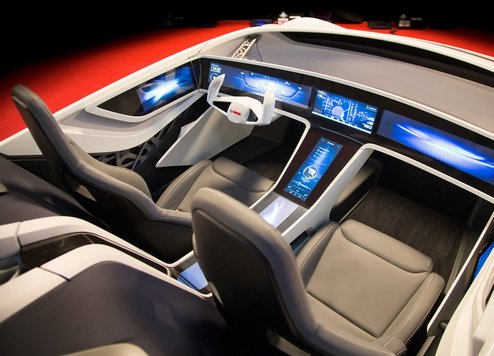 Bosch has a whole ecosystem of connections to connect cars to the Internet of Things – home, cities, life and work. Bosh offers many levels of the IoT with its sensors, IoT software, and a diverse range of services.
Bosch has a whole ecosystem of connections to connect cars to the Internet of Things – home, cities, life and work. Bosh offers many levels of the IoT with its sensors, IoT software, and a diverse range of services.
Bosch’s vision for the future in 2020 personalizes the entire car, the color on the outside, settings and contacts. When you get into the car, a biometric sensor knows it is you and changes the settings for you. Your fingerprint starts the car. The HMI has multi-modal interaction with haptic touch, gestures and eye gaze. 3D surround views helps you get into a parking space and also lets you check to see if it is safe for you to get out. Bosch is developing the way to the third living space.
Bosch received a CES 2016 Innovation Award in the In-Vehicle Audio/Video category for a new touchscreen. This device can generate different surface textures, allowing elements to be felt on the display.
Instead of looking at the controls the driver can feel the different controls. The screen generates the feel of rough, smooth, and patterned surfaces to indicate different buttons and functions; to make a selection, a button needs to be pressed more firmly. It looks like a touchscreen but feels like hard buttons.
AT CES Bosch showed solutions to make life easier and safer through connectivity, sensors, software and for people, cars, homes an cities.(see videos below)
Bosch’s main goal for automated driving is to make driving safer. Bosch will have fully automated parking aka valet parking by 2018.
Bosch would like to connect technology to smart cities, vehicles, traffic lights, charging, parking and transportation infrastructure. All the connections should make life better for every one.
Currently, Bosch offers a cloud-based alert that warns drivers within ten seconds if there is a wrong-way driver approaching. The warning system, is a connected lifesaver in the true sense of the word.
To connect the car with the internet, Bosch has two main approaches. First, it makes full use of the driver’s smartphone. Using the integrated mySPIN solution, drivers can link their Android and iOS devices to the vehicle’s infotainment system. Selected apps can then be conveniently operated from the vehicle’s central display.
Bosch’s second approach constitutes equipping the vehicle with connectivity hardware in the form of a connectivity control unit, or CCU. The CCU receives and transmits information using a wireless module equipped with a SIM card. It can also determine the vehicle’s position using GPS if desired. Bosch offers devices specifically adapted to cars, commercial vehicles, motorcycles, off-highway vehicles, and even railway freight cars..
Information on traffic jams, black ice, and wrong-way drivers is available in the cloud. When combined with infrastructure data from parking garages and charge spots, this provides a broader perspective – the “connected horizon”. Connectivity also enhances vehicle efficiency. For example, precise data about traffic jams and the road ahead makes it possible to optimize charging management in hybrid and electric vehicles along the selected route. And because the car thinks ahead, the diesel particulate filter can be regenerated just before the car exits the freeway, and not in the subsequent stop-and-go traffic. Connectivity improves convenience as well, as it is a prerequisite for automated driving. It is the only way to provide unhurried braking in advance of construction zones, traffic jams, and accident scenes.
The connected car also captures data on the operation of individual components. Running this data through sophisticated algorithms permits preventive diagnostics. It can predict what parts will need replacing before the car breaks down on the road.
Bosch claims that all of it technology will make for much better and safer lives.